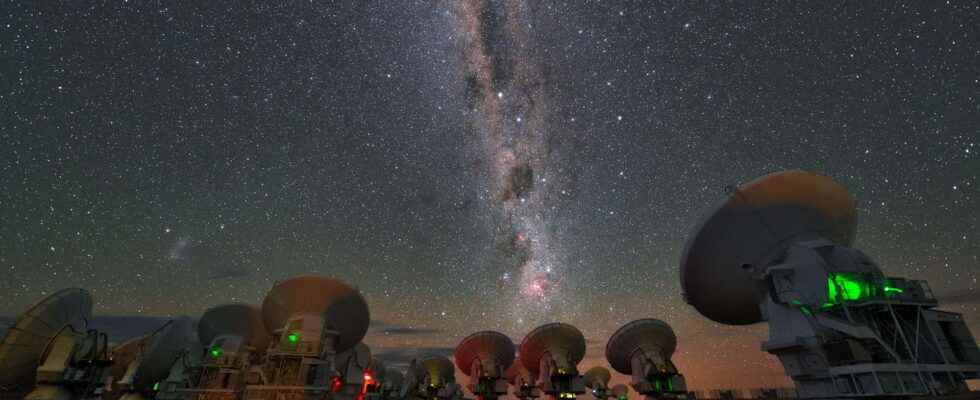According to a study published in Nature on November 9, the galactic center of the Milky Way would be impermeable to cosmic radiation. A team of researchers based in China has observed the existence of a “barrier” preventing this radiation from reaching Sagittarius A *, without this phenomenon being able to be explained.
The center of the Milky Way continues to arouse the interest of the scientific community. A team of researchers from the Nianjing Academy of Sciences in China published on November 9 in Nature an article on a phenomenon observable around the galactic nucleus. By studying data from different telescopes having observed the center of the galaxy in the spectrum gamma. The astronomers found that while the area around supermassive black hole Sagittarius A * emitted cosmic radiation in large quantities and at high speed, on the other hand, the center of the Milky Way turns out to be impermeable to these same radiations, which seem to be stopped by a virtual “barrier”.
The mystery of cosmic rays
The cosmic radiation cross theUniverse at high speed, and are composed of subatomic particles such as neutrons, electrons Where protons, constitutive of atoms. They can have various origins: some rays come from stars during events such as solar flares and the ejection of mass coronal, we then speak of solar radiation. However, some so-called galactic rays come from further away in the galaxy. These radiations are caused by the explosion of massive stars in supernovae and the resulting particles can sometimes split the cosmos at speeds close to that of light, or 299,000 kilometers per second.
The astrophysicists from Nanjing have oriented the Fermi satellite, telescope networks HESS (for High Energy Stereoscopic System) and other “atmospheric Cherenkov imaging” devices towards the center of the Milky Way, where the the black hole supermassif Sagittarius A * at 25.640 light years of Solar system. Around Sagittarius A * (sometimes shortened to Sgr A *) is a region named Central Molecular Zone (CMZ or Central Molecular Zone), composed of clouds of gas molecular giants. These clouds are veritable nurseries of stars, sometimes extending over several parsecs (one parsec equals 3.26 light years or 30.900 billion kilometers). The central molecular zone is extremely dense, its mass being estimated at 60 million solar masses (M☉). In this same zone, several elements are considered as particle accelerators that can cause cosmic rays : we find jumbled together novae, from retentive supernovae or plerions (or nebulae of winds of pulsars).
Invisible barrier
The researchers therefore found theemission of cosmic rays from the galactic center. But the radiations outside the center of the Milky Way, divided into a veritable “sea “ (so called by the study) through the galaxy, cannot enter this region. Data collected from HESS observations, Fermi and other telescopes demonstrate a sudden drop in density of these rays to outskirts of the sector. Several theories can explain the existence of this invisible border, caused by possible compressions of the magnetic field molecular clouds, repelling cosmic radiation. The study establishes a analogy with bass particles energy unable to penetrate the Solar System due to the magnetic field of the sun during periods of activity of the star.
The mystery of the invisible barrier surrounding the galactic center is therefore likely to persist, but researchers should now embark on the study of this still little-known phenomenon.
—
Futura in the Stars, it is the unmissable event for lovers of astronomy and space. Every 1st of the month, meet us for a complete tour of the ephemeris of the month, with advice on how to best observe what is happening in the sky. A special episode published every 15th of the month will offer you to learn more about a particular object or event that will mark astronomical and space news.
—
Interested in what you just read?
.
fs3
